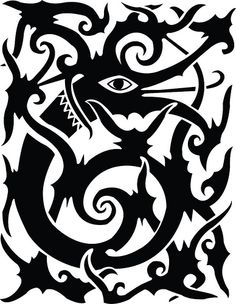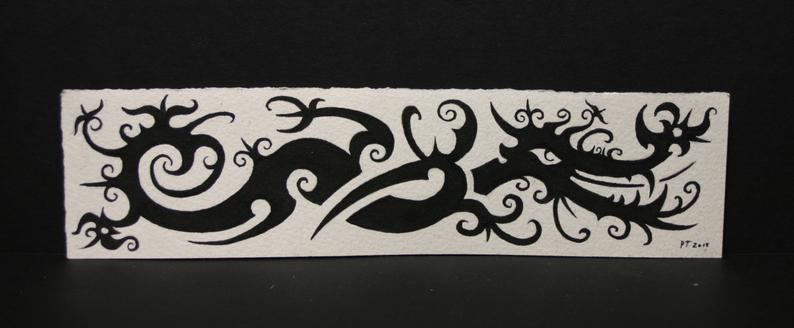“In short, you want us to risk our lives to steal a pearl from a dragon with six heads without telling us why you need it for?” Standing with his hands on his hips, Sampurai narrowed his eyes.
Laja, who was sitting on the tall buttressed tree root right in front of him, nodded firmly. “I’m sorry I can’t tell you why I need the pearl. If you don’t want to help me, I understand. No offense taken. Watt and Dom have agreed to help under the same condition. It would be great if you can join us. We could use the extra help. But if you don’t want to, the three of us will have to try our best without you.”
“I’m in! I’m in!” Sampurai quickly confirmed. A chance to fight with a dragon with six heads? He wouldn’t miss it for the world!
(Excerpt from ‘Crocodile Tears’, 2015)
Despite being a mythical creature, dragons appear in various folklore of many cultures around the world.
In Western culture, it is typically depicted as winged, horned, four-legged and capable of breathing fire. Meanwhile, dragons in Eastern culture are usually wingless (but capable of flight) short-legged, serpentine creatures.
Would it be interesting to know that the dragon in Iban folklore is a bit of both worlds?

Here is a post written by Patricia Hului on a website kajomag.com about the Iban dragons.
(Patricia Hului is a Kayan who wants to live in a world where you can eat whatever you want and not gain weight. She grew up in Bintulu, Sarawak and graduated from the University Malaysia Sabah with a degree in Marine Science. She worked for The Borneo Post SEEDS, which is now defunct. When she’s not writing, you can find her in a studio taking belly dance classes, hiking up a hill or browsing through Pinterest.)
—–
Here are a few things you should know about dragons in Iban folklore:
1. The physical appearance of a dragon in Iban folklore:
According to an Iban legend, a dragon or ‘naga’ is a huge snake with a horn protruding from its forehead.
Unlike its fellow dragons from other folklore, an Iban dragon has a luminous bezoar or ‘gombala’ stone in the center of its brow. It works like a flashlight for the dragon to light its way at night.
It also has a pair of wings, legs, arms, eyes and sharp claws and teeth.
2. There are two species of dragons
According to Iban ethnologist Benedict Sandin, there are two species of dragons in Iban folklore. One species loves the water so it lives in the sea, pool or in the river. Meanwhile, another species prefers the mountain top.
The one which lives on the mountain top kills with its crested tail. It can also spit venom and breathe fire.
3. It is believed that a dragon protected the Ibans during the infamous Cholera expedition
Benedict wrote in The Sarawak Gazette on Nov 30, 1964, “It was said by the Ulu Ai Ibans during the Cholera Expedition against Penghulu Bantin of Delok in 1902, before the arrival of the Government forces at the mouth for Delok river in the upper Batang Ai, that they saw a huge dragon track going down from the hill to the river. During the following night Bantin had a dream. He dreamt that he met a huge dragon which told him not to worry about the enemy as he (the dragon) would fight for him.”
Eventually, one fifth of the 10,000 men recruited to fight the alleged rebels died of Cholera hence the name ‘Cholera Expedition’.
4. A dragon also helped fight the Japanese during World War II
When an Iban leader, the late Temenggong Koh fought against the Japanese during World War II, he gave offerings to the dragon god seeking its protection.
Benedict shared, “It was due to this that whenever the late Temenggong Koh was worried by the enemy he would throw an offering into the river to appeal for immediate help from his dragon god. He did this during the fighting against the Japanese soldiers at the town of Song during liberation days in 1945.”
—–

Obviously the dragon with six heads in ‘Crocodile Tears’ is a work of fantasy of mine as any other creatures written in TROPAWS. They are originated from Iban mythology, but their presence and roles in the stories have been extended to reach the fullest dramatic effects.
If you are to write your own fantasy story, what would your dragon be like?
Interesting, could Dragons be some racial memory of the Dinosaurs? Or, could they be real?
Interesting thoughts. I never thought of making a relation between dragons and dinosours.
With so many cultures around the world telling stories of dragons (in their various forms), I am more inclined to believe that there must be something about them that is real (read: that’s my wishful thinking).
I believe they may be related. But Dragon’s do have a decidedly spiritual power about them. I do believe they may yet exist in the realm of the spirits. But this is also my hopeful wish.
thank you for these articles, where I can learn more about the culture of Borneo and above all the graphics they used to decorate both the body and the objects of common use. Do you have any books to recommend? Thanks again
Hello, sorry for the late reply. If you’d like to know more about traditional Iban designs, there is a book called “Basic Iban Design” by Augustine Anggat Ganjing. You can try the following link to inquire further: https://www.worthpoint.com/worthopedia/book-of-basic-iban-design-tattoo-dayak-borneo
Good luck with your search.